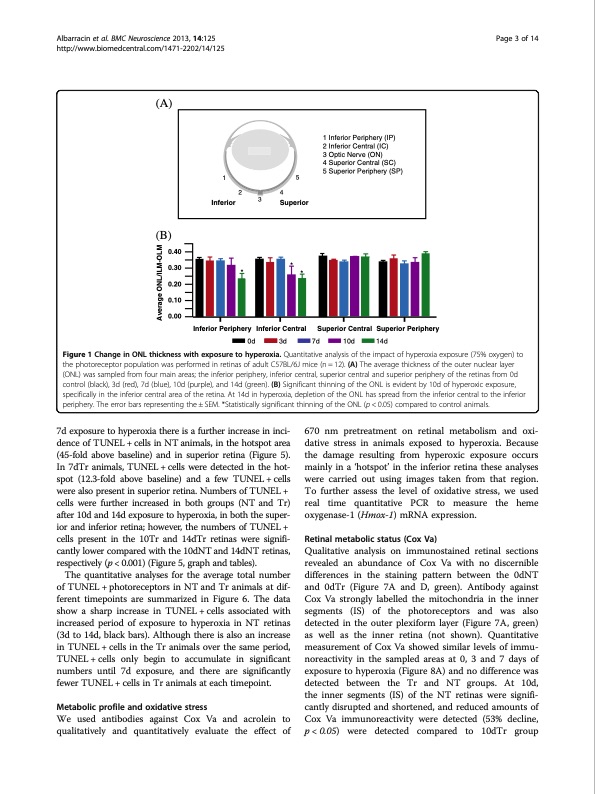
PDF Publication Title:
Text from PDF Page: 003
Albarracin et al. BMC Neuroscience 2013, 14:125 http://www.biomedcentral.com/1471-2202/14/125 Page 3 of 14 (A) (B) 0.40 0.30 0.20 0.10 0.00 * 15 24 1 Inferior Periphery (IP) 2 Inferior Central (IC) 3 Optic Nerve (ON) 4 Superior Central (SC) 5 Superior Periphery (SP) Inferior 3 Superior * * Average ONL/ILM-OLM Inferior Periphery Inferior Central Superior Central Superior Periphery 0d 3d 7d 10d 14d Figure 1 Change in ONL thickness with exposure to hyperoxia. Quantitative analysis of the impact of hyperoxia exposure (75% oxygen) to the photoreceptor population was performed in retinas of adult C57BL/6J mice (n = 12). (A) The average thickness of the outer nuclear layer (ONL) was sampled from four main areas; the inferior periphery, inferior central, superior central and superior periphery of the retinas from 0d control (black), 3d (red), 7d (blue), 10d (purple), and 14d (green). (B) Significant thinning of the ONL is evident by 10d of hyperoxic exposure, specifically in the inferior central area of the retina. At 14d in hyperoxia, depletion of the ONL has spread from the inferior central to the inferior periphery. The error bars representing the ± SEM. *Statistically significant thinning of the ONL (p < 0.05) compared to control animals. 7d exposure to hyperoxia there is a further increase in inci- dence of TUNEL + cells in NT animals, in the hotspot area (45-fold above baseline) and in superior retina (Figure 5). In 7dTr animals, TUNEL + cells were detected in the hot- spot (12.3-fold above baseline) and a few TUNEL + cells were also present in superior retina. Numbers of TUNEL + cells were further increased in both groups (NT and Tr) after 10d and 14d exposure to hyperoxia, in both the super- ior and inferior retina; however, the numbers of TUNEL + cells present in the 10Tr and 14dTr retinas were signifi- cantly lower compared with the 10dNT and 14dNT retinas, respectively (p < 0.001) (Figure 5, graph and tables). The quantitative analyses for the average total number of TUNEL + photoreceptors in NT and Tr animals at dif- ferent timepoints are summarized in Figure 6. The data show a sharp increase in TUNEL + cells associated with increased period of exposure to hyperoxia in NT retinas (3d to 14d, black bars). Although there is also an increase in TUNEL + cells in the Tr animals over the same period, TUNEL + cells only begin to accumulate in significant numbers until 7d exposure, and there are significantly fewer TUNEL + cells in Tr animals at each timepoint. Metabolic profile and oxidative stress We used antibodies against Cox Va and acrolein to qualitatively and quantitatively evaluate the effect of 670 nm pretreatment on retinal metabolism and oxi- dative stress in animals exposed to hyperoxia. Because the damage resulting from hyperoxic exposure occurs mainly in a ‘hotspot’ in the inferior retina these analyses were carried out using images taken from that region. To further assess the level of oxidative stress, we used real time quantitative PCR to measure the heme oxygenase-1 (Hmox-1) mRNA expression. Retinal metabolic status (Cox Va) Qualitative analysis on immunostained retinal sections revealed an abundance of Cox Va with no discernible differences in the staining pattern between the 0dNT and 0dTr (Figure 7A and D, green). Antibody against Cox Va strongly labelled the mitochondria in the inner segments (IS) of the photoreceptors and was also detected in the outer plexiform layer (Figure 7A, green) as well as the inner retina (not shown). Quantitative measurement of Cox Va showed similar levels of immu- noreactivity in the sampled areas at 0, 3 and 7 days of exposure to hyperoxia (Figure 8A) and no difference was detected between the Tr and NT groups. At 10d, the inner segments (IS) of the NT retinas were signifi- cantly disrupted and shortened, and reduced amounts of Cox Va immunoreactivity were detected (53% decline, p<0.05) were detected compared to 10dTr groupPDF Image | 670 nm light mitigates oxygen-induced degeneration 2013

PDF Search Title:
670 nm light mitigates oxygen-induced degeneration 2013Original File Name Searched:
670nm-light-mitigates-oxygen-induced-degeneration-in-mouse-retina.pdfDIY PDF Search: Google It | Yahoo | Bing
Cruise Ship Reviews | Luxury Resort | Jet | Yacht | and Travel Tech More Info
Cruising Review Topics and Articles More Info
Software based on Filemaker for the travel industry More Info
The Burgenstock Resort: Reviews on CruisingReview website... More Info
Resort Reviews: World Class resorts... More Info
The Riffelalp Resort: Reviews on CruisingReview website... More Info
| CONTACT TEL: 608-238-6001 Email: greg@cruisingreview.com | RSS | AMP |